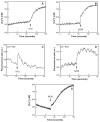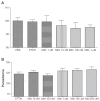Unlike the synchronous Plasmodium falciparum and P. chabaudi infection, the P. berghei and P. yoelii asynchronous infections are not affected by melatonin
- PMID: 20360886
- PMCID: PMC2840578
- DOI: 10.2147/ijgm.s3699
Unlike the synchronous Plasmodium falciparum and P. chabaudi infection, the P. berghei and P. yoelii asynchronous infections are not affected by melatonin
Abstract
We have previously reported that Plasmodium chabaudi and P. falciparum sense the hormone melatonin and this could be responsible for the synchrony of malaria infection. In P. chabaudi and P. falciparum, melatonin induces calcium release from internal stores, and this response is abolished by U73122, a phospholipase C inhibitor, and luzindole, a melatonin-receptor competitive antagonist. Here we show that, in vitro, melatonin is not able to modulate cell cycle, nor to elicit an elevation in intracellular calcium concentration of the intraerythrocytic forms of P. berghei or P. yoelii, two rodent parasites that show an asynchrononous development in vivo. Interestingly, melatonin and its receptor do not seem to play a role during hepatic infection by P. berghei sporozoites either. These data strengthen the hypothesis that host-derived melatonin does not synchronize malaria infection caused by P. berghei and P. yoelii. Moreover, these data explain why infections by these parasites are asynchronous, contrary to what is observed in P. falciparum and P. chabaudi infections.
Keywords: calcium; cell cycle; malaria; melatonin; rhythm; sporozoite.
Figures






Similar articles
-
Products of tryptophan catabolism induce Ca2+ release and modulate the cell cycle of Plasmodium falciparum malaria parasites.J Pineal Res. 2005 Oct;39(3):224-30. doi: 10.1111/j.1600-079X.2005.00249.x. J Pineal Res. 2005. PMID: 16150101
-
Host Porphobilinogen Deaminase Deficiency Confers Malaria Resistance in Plasmodium chabaudi but Not in Plasmodium berghei or Plasmodium falciparum During Intraerythrocytic Growth.Front Cell Infect Microbiol. 2020 Sep 3;10:464. doi: 10.3389/fcimb.2020.00464. eCollection 2020. Front Cell Infect Microbiol. 2020. PMID: 33014890 Free PMC article.
-
Different responses of three rodent Plasmodia species, Plasmodium yoelii 17XL, P. berghei NK65 and P. chabaudi AS on treatment with febrifugine and isofebrifugine mixture from Hydrangea macrophylla var. Otaksa leaf in ICR mice.Phytother Res. 2003 Jun;17(6):650-6. doi: 10.1002/ptr.1219. Phytother Res. 2003. PMID: 12820234
-
Malaria: therapeutic implications of melatonin.J Pineal Res. 2010 Jan;48(1):1-8. doi: 10.1111/j.1600-079X.2009.00728.x. J Pineal Res. 2010. PMID: 20025640 Review.
-
Effects of melatonin derivatives on human malaria parasite Plasmodium falciparum.Recent Pat Endocr Metab Immune Drug Discov. 2014;8(2):102-8. doi: 10.2174/1872214808666140616143623. Recent Pat Endocr Metab Immune Drug Discov. 2014. PMID: 24935182 Review.
Cited by
-
Host-mediated impairment of parasite maturation during blood-stage Plasmodium infection.Proc Natl Acad Sci U S A. 2017 Jul 18;114(29):7701-7706. doi: 10.1073/pnas.1618939114. Epub 2017 Jul 3. Proc Natl Acad Sci U S A. 2017. PMID: 28673996 Free PMC article.
-
Malaria parasites and circadian rhythm: New insights into an old puzzle.Curr Res Microb Sci. 2020 Dec 14;2:100017. doi: 10.1016/j.crmicr.2020.100017. eCollection 2021 Dec. Curr Res Microb Sci. 2020. PMID: 34841309 Free PMC article.
-
Melatonin and IP3-induced Ca2+ release from intracellular stores in the malaria parasite Plasmodium falciparum within infected red blood cells.J Biol Chem. 2011 Feb 18;286(7):5905-12. doi: 10.1074/jbc.M110.188474. Epub 2010 Dec 13. J Biol Chem. 2011. PMID: 21149448 Free PMC article.
-
Decoding the Role of Melatonin Structure on Plasmodium falciparum Human Malaria Parasites Synchronization Using 2-Sulfenylindoles Derivatives.Biomolecules. 2022 Apr 26;12(5):638. doi: 10.3390/biom12050638. Biomolecules. 2022. PMID: 35625565 Free PMC article.
-
The contribution of Plasmodium chabaudi to our understanding of malaria.Trends Parasitol. 2012 Feb;28(2):73-82. doi: 10.1016/j.pt.2011.10.006. Epub 2011 Nov 17. Trends Parasitol. 2012. PMID: 22100995 Free PMC article. Review.
References
-
- Garcia CR, Takeuschi M, Yoshioka K, et al. Imaging Plasmodium falciparum-infected ghost and parasite by atomic force microscopy. J Struct Biol. 1997;119:92–98. - PubMed
-
- Przyborski JM, Lanzer M. Protein transport and trafficking in Plasmodium falciparum-infected erythrocytes. Parasitology. 2005;130:373–388. - PubMed
-
- Boyd GH. Induced variations in the asexual cycle of Plasmodium cathemerium. Am J Hyg. 1929;9:181–187.
-
- Taliaferro WH, Taliaferro LG. Morphology, periodicity and course of infection of Plasmodium brasilianum in Panamanian monkeys. Am J Hyg. 1934;20:1–49.
LinkOut - more resources
Full Text Sources

